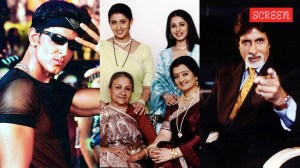The future is here
The first Kindle owners in India tell us how it has changed the way they read
The first Kindle owners in India tell us how it has changed the way they read
The library in her home is Reeti Roys sanctuary. The drone of south Kolkata traffic is muffled by the time it reaches the room,a large mahogany desk rests in the middle and walls of books surround it. I love to curl up with a book here, says Reeti,a student of English literature. She shares the library with her father,Roopen Roy,a chartered accountant with a passion for books. Two months ago,Roys reading world changed when he bought the Amazon e-reader,Kindle. I am hooked, he says.
The slim contraption that has taken the publishing world by storm sits on a desk in his library,resting against a copy of Orhan Pamuks Museum of Innocence. Its light to hold (around 300 g),the size of a biggish paperback,the white spare body almost pure in the morning light,a thing untouched,a thing not to be dog-eared or pencilled or held close to the nose and smelt. It is powered by a technology which has shrunk a 512-page book into bits of memory and can store more than 1,500 books. Roy has travelled around the world with it and finds it particularly useful during long flights. Recently,I was in mood for some poetry,so I downloaded a lot of Khayyam, he says. The Kindle is equipped with a wi-fi connection and you can get a book off the Amazon site for $10 a download. There is also a library of free e-books to be streamed off the site,which includes most classics in the common domain.
Roy navigates from one page to another with the press of a button. You can also change the size of the font. It is easy on the eyes. That is a boon for the weak-sighted, he says.
Yet,Reeti is unimpressed. Can you curl up with it in your bed? she asks.
Amazon decided to ship Kindles to India in October last year. Since then,a few newspapers have started Kindle editions. Publishing houses here have been slow off the mark. The only Indian books available are three titles from Wisdom Tree: Mantras: The Sacred Chants by Swami Veda Bharati,Yogini: Unfolding the Goddess Within by Shambhavi Chopra and Ting by Arupa Tesolin.
For 30-year-old Delhi based software professional,Vaibhav Gadodia,though,the e-reader is a dream come true. He says he waited for months for the device to be launched and almost grabbed a copy,not worrying about the Rs 18,000 he had to shell out ($279 plus shipping charges). He describes himself as one who considers reading to be a vocabulary-building exercise. He has reasons to warm up to Kindle. Isnt it frustrating when you are confronted with unknown words while reading? Well,Kindle does away with that with its built-in dictionary. All you need to do is click on the word and you know the meaning, says Gadodia.
Media professional Hema Gupta from Mumbai is a new Kindle-convert. It has certain features,such as being able to sample bits of books at no cost from the Amazon store,that will get more people to read. Its useful for academics who are always reading and have to lug books around, says Gupta.
Some are even hailing the device as the green machine. Its after all a device that is saving trees,one Kindle at a time. It feels good to know that we are not felling trees for our pleasure. It is guilt-free reading, says Gadodia.
Other publishing giants like Barnes & Noble have launched their version of e-book readers. Barnes & Nobles Nook can store more books than Kindle and has a built-in MP3 player; Sonys e-book reader has a repository of 5 lakh books through a tie-up with Google. If I had waited a few months,I could have opted for Nook,which also has a colour display, says Roy. And then of course there is Apples tablet,an iPhone and e-reader rolled into one,which is being touted as the Kindle-killer and might be released this year.
In India,a Kerala-based publication house,DC Books,plans to unveil an Indian e-book reader by May. It will be cheaper than Kindle,and will be functional in a number of Indian languages including Hindi and Marathi. It will also have an in-built messaging device, says Ravi DC of DC Books. Its USP: the price. Downloads will be really cheap, says Ravi. Wisdom Tree has decided to put up 12 more titles on Kindle and has also tied up with Nook,says its publisher Shobit Arya.
So is this the future of reading? Its not a resounding yes. Roy,for instance,continues to buy dead-tree books even after the Kindle,Pamuks latest being one of them.
E-readers are good options for slow readers (it lets you hoard on borrowed books for over two weeks),fickle readers (it lets you sample books) and those who put a book aside for five or 10 years and then take it up again (its gigantic memory space lets you store books aplenty). I am on holiday in Mexico now and I can read hundreds of books on my Kindle,depending on the paper I am working on,and what my mood is at the moment. Instead of worrying about the future of books,we should look at what new cultures of reading the Kindle might encourage, says Gupta.
But for traditional readers,insists novelist Rimi B Chatterjee,Kindle will only be another convenient option. We have had soft copies of books for a long time. That didnt spell doom for printed books,did it? Kindle might coax those intimidated by books to get into the habit of reading, she says. There are other drawbacks. The Kindle allows access only to books available on Amazon instead of being a portal to numerous online bookstores. It doesnt allow you to loan or share a book or even re-sell it.
Certain books might also diminish in experience in the e-book format. Do you see an e-format of a coffee table book? Some books need to be held and felt, says Rakesh Khanna of Chennai-based Blaft publications. Bangalore-based graphic novelist,George Mathan,author of Moonward,welcomes e-readers as innovations. But they will never replace the original thing, he says.




- 01
- 02
- 03
- 04
- 05



























